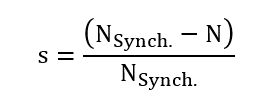Inputs
1. Standard inputs
-
Line-line voltage, rms
The line-line voltage supplied to the machine: “Line-line voltage, rms” ( Line-line voltage, rms value ) must be provided.
-
Slip or Speed mode
There are two usual parameters to define the working point. It can be defined by the slip “ Slip ” or by the rotor speed “ Speed ”.
-
Slip
If the “Definition mode” is “ Slip ”, the value of the machine’s slip must be provided, and the corresponding speed is deduced.
The slip “s” in the following relations) corresponds to the relative difference between the synchronous speed (N Synch. ) and rotor speed N:

-
Speed
If the “Definition mode” is “ Speed ”, the targeted rotor speed must be provided, and the resulting slip is deduced.
-
Power supply frequency
The power supply frequency corresponds to the electrical frequency of the stator magnetic field.
-
Represented coil conductors
In transient application, it is possible to export a project into Flux environment where the elementary wires will be modeled with solid conductors. The geometry, the meshing and the corresponding electric circuit will be defined to well represent them.
One choice is possible:
- “All phases”: The elementary wires will be represented into all the phases
2. Advanced inputs
The list of advanced inputs dedicated to this export are listed below.
For more details please refer to the section 3.7.4 - List of generic advanced inputs.
-
Number of computations per electrical period
The default value is equal to 50. The minimum allowed value is 13.
-
Number of computed electrical periods
The default value is equal to 2. The minimum allowed value is 1 and the maximum value is equal to 10.
- Rotor initial position
-
Mesh order
The default level is second order mesh.
-
Airgap mesh coefficient
Airgap mesh coefficient is set to 1.5 by default.